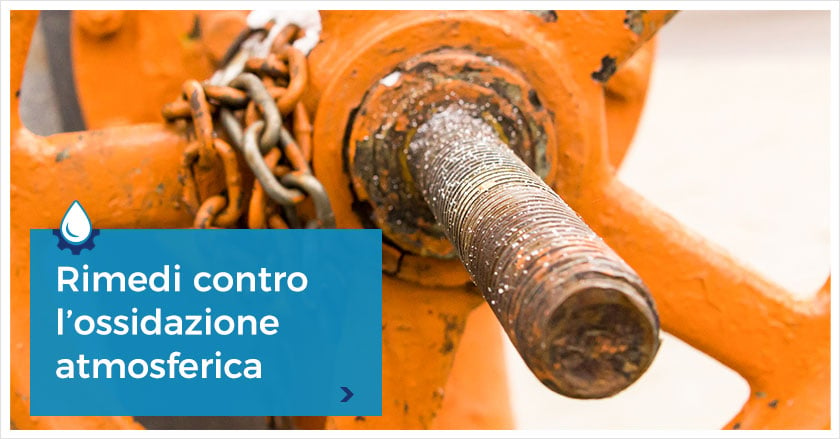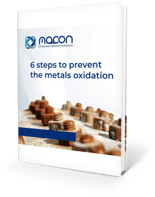Based on the ferrous material to be protected, the function of the component and the environmental conditions, the ideal anti-oxidation solution must respect specific characteristics and thus requires a precise formulation studied in detail.
Do you want to determine all the properties that a good lubricant must have to protect against oxidation? Download the guide and find out all the details.

Remedies against atmospheric oxidation
The oxidation of metals is the main enemy of the most common ferrous materials used for the manufacture of mechanical devices. It is an inevitable phenomenon but the effects can be reduced through appropriate measures during the production process and during transport, including the use of an anti-oxidation/anti-corrosion protective lubricants.
Atmospheric corrosion: what it is and how does it occur?
Oxidation leads to inevitable corrosion of the metal. Here, we will deal with wet or atmospheric corrosion under which a metal tends to oxidize due to the atmospheric conditions of the environment in which it is located, being the presence of an aqueous film that dissolved oxygen in the medium.
The atmospheric oxidation process requires the following elements for its development:
- Ferrous metal substrate, or in any case not self-passivating
- Presence of H2O
- An oxidizing environment (presence of dissolved oxygen in the air-water medium)
Wet corrosion prevention systems - paints and coatings
Ferrous alloys are subject to atmospheric oxidation and must be protected during their normal operation by coatings of various types and compositions. Depending on the production phase within which the semi-finished or finished products are located, and according to the needs, two types of coatings can be distinguished:
Temporary
These consist in the application of removable protective barriers and are recommended when subsequent passivation operations (coating or painting) are envisaged.
Permanent
This type has the objective of preventing the formation of iron oxides for the entire temporal exercise of the device, divided into galvanic treatments (thin passivating compound layers such as phosphating, zinc plating) and painting (definitive coatings applied before the device is put into operation).
Characteristics of an excellent temporary protection for metals
It is thus important to apply very effective temporary protective solutions to ferrous metal surfaces, with the main requirements for superior protection being:
- High degree of protection, generally measured in hours of salt spray or wet room according to ASTM B-117
- Reduced content of volatile particles, commonly identified as VOCs (Volatile Organic Compounds), being unhealthy for operators who use the solution in production departments
- Easy application through simple dispensing systems
- Easy removal to make the components ready for subsequent surface treatments that may be envisaged
- Compatibility with the surfaces to be protected to avoid variations in gloss, colour, roughness and predisposition to chemical attack
- Reduced environmental impact
Solutions against the oxidation of metals
The main temporary protective solutions can be classified into:
- Protective oils, being oily fluids of a mineral or synthetic nature, enriched with additives and corrosion inhibitors
- Corrosion inhibitors, as concentrated saline solutions to be diluted in mains water up to percentages of 3–5%, suitable for testing valves, pumps, heat exchangers and pressure equipment
- Emulsifiable mineral or synthetic oils formulated with surfactants for easy suspension in water, being suitable for tests such as corrosion inhibitors, in concentrations up to 10% and which allow component protection even after testing for up to 12 months in a closed environment
- Pastes and gels, being fatty compounds with high protective power, suitable for use in mechanical devices, such as actuators, gears and kinematics operating in external parts, usually used as lubricants but with an ennobled formulation of oxidation inhibitor additives
- Dry film coatings, being dispersions of fast evaporating protective waxes in solvent, leaving a dry film on the metal surfaces that is particularly resistant to washoff
- VpCI, or polyethylene papers, impregnated with corrosion inhibitors to create a protective barrier against saline mists and produce a reducing (protective) atmosphere around the semi-finished product, being suitable for special packaging during transports overseas
Based on the ferrous material to be protected, the function of the component and the environmental conditions, the ideal anti-oxidation solution must respect specific characteristics and thus requires a precise formulation studied in detail.
Do you want to know about all the properties that a good lubricant should have to protect against oxidation? Download the guide to find out all the details.




